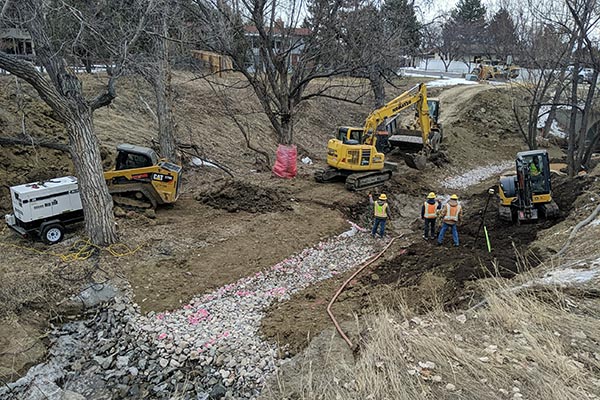Mail Creek Clean-Up#

As a part of the Mail Creek Stream Rehabilitation Project, contractors discovered buried abandoned building materials that contain asbestos. The materials are currently stabilized under plastic and pose minimal exposure potential. This area is being remediated according to State regulations and is off-limits to unauthorized personnel.
If you have questions or concerns, you can contact us at 970-416-2320.
FAQ#
-
Asbestos is a naturally occurring mineral that was widely used in construction, manufacturing, and other industries due to its unique properties, such as resistance to heat, fire and chemical damage. Asbestos fibers are strong, flexible, durable and were commonly used in insulation, roofing materials, floor tiles and other products.
-
Asbestos is made up of microscopic bundles of fibers that may become airborne when disturbed. If these fibers get into the air, they can be inhaled into the lungs which can cause significant health problems. Exposure to asbestos fibers can cause a range of serious health conditions, including lung cancer, mesothelioma and asbestosis. These conditions may not appear for many years after exposure, making it important to take steps to prevent exposure whenever possible.
Despite the common misconception, exposure to asbestos fibers does not cause headaches, upper respiratory irritation or other immediate symptoms. As mentioned above, the effects often go unnoticed for 15-50 years.
-
During the Mail Creek Stream Rehabilitation Project, third-party contractors excavated an unknown, old farm dump that was determined to contain asbestos. Immediate precautions were taken to prevent exposure.
-
There are protective measures that can be implemented to prevent exposure. The risk associated with asbestos occurs when it’s damaged, which allows it to become airborne and inhaled. To prevent the continued release of asbestos fibers into the air, the site has been properly stabilized. Stabilization typically involves encapsulating the material with a binding agent or covering it with a barrier.
-
Removal typically involves excavation of the contaminated soil and debris which are then disposed of at a licensed landfill facility. The City is working with the Colorado Department of Public Health and Environment to perform remediation in a way that does not expose workers or the public.
-
There are protective measures that can be implemented to prevent exposure. The risk associated with asbestos occurs when it’s damaged, which allows it to become airborne and inhaled. To prevent the continued release of asbestos fibers into the air, the site has been properly stabilized. Stabilization typically involves encapsulating the material with a binding agent or covering it with a barrier.
-
Similar to humans, the risk to pets occurs when asbestos is airborne and inhaled. The precautions taken also protect your pets and wildlife.
-
It is important for individuals to stay out of the fenced-in area in order to avoid exposure to the hazardous materials. The area is staked off with appropriate signage to indicate the location of concern.
-
While protective measures have been installed to prevent exposure, state regulations require language to be posted to ensure no unauthorized people enter the contamination area and protective measures stay in place.
-
Yes, your water is safe. The identified contamination and remediation efforts do not impact your drinking water.
Did You Know?
You can save money by shifting your electric use to the lower-priced, off-peak hours or by reducing your overall use.
Fats, oils and grease can clog the pipes in your home and the City’s wastewater system. Don’t put them down the drain. Toss them instead.
Financing home energy upgrades and solar is now easier than ever with the Epic Loan.